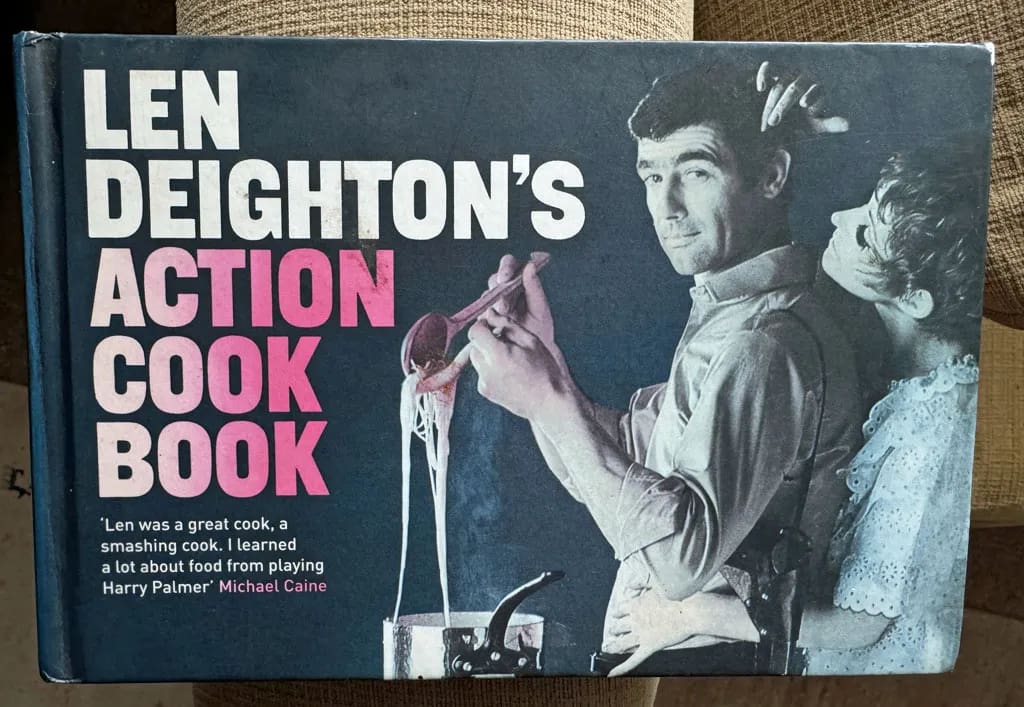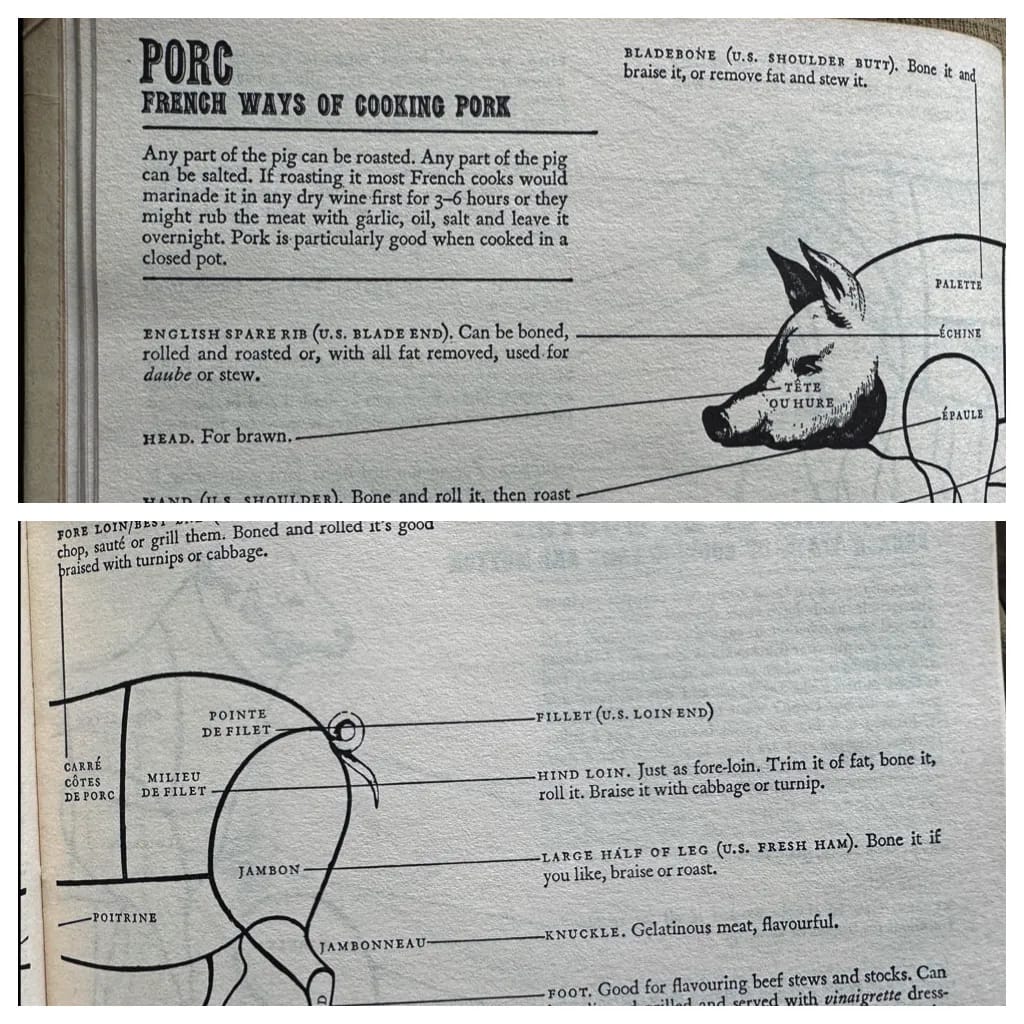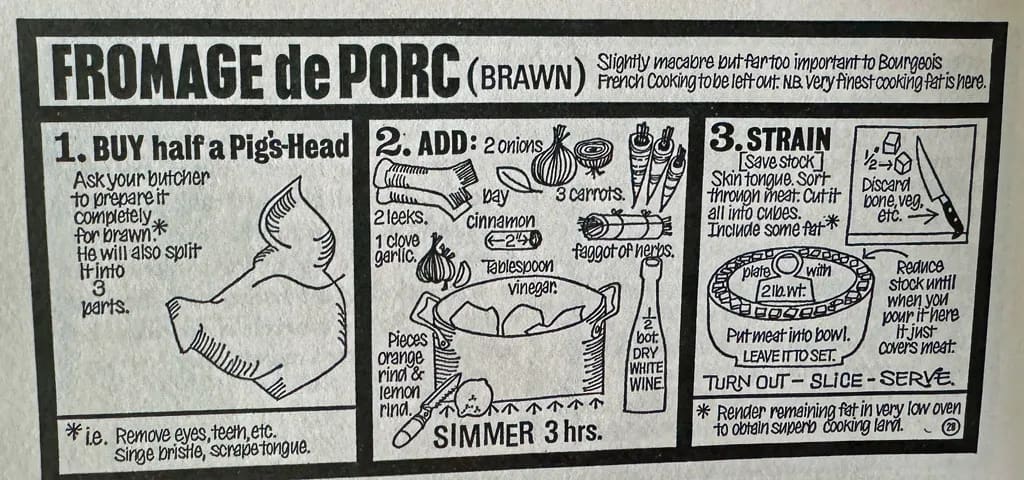This was apparently how one of the publishers described this book. Picking up on the Ipcress File buzz of course.
I have copies of two of Len Deighton’s cookbooks: a US, 1977 edition of “Ou Est Le Garlic”

and the re-issued 2009 version “Action Cook Book” (which first came out in 1965!)

One of the earlier cover ‘photos was equally striking

Writer, cook and artist (he did the fantastic comic-strip illustrations you’ll see below). Unfairly gifted you say? Well, maybe. Self-taught, so all his own work.
Deighton, in order to pay his way through the RCA, and alongside the occasional commission for illustrations, had taken a job in the kitchens of the Festival Hall. His understanding of cooking, and a particular affinity with offal, had started at the family home in Marylebone (he describes his mother as a ‘superb’ cook). Rather than take his growing collection of valuable cookery books to his new place of work, he set about summarising key dishes using illustrations and much shorter instructive text…. Deighton’s hospitality was to be the catalyst behind the appearance of his handmade cook strips in the national press. It was Hawkey – now at The Observer – who spotted one of these cook strips during supper at Deighton’s house. He suggested improvements, including the attention of a lettering expert to improve on Deighton’s own hand and the addition of a rudimentary grid. With those, he felt the strips might be publishable. They would form another piece of an increasingly graphic approach to the look of newspapers.
There’s also a hugely detailed fanzine blog available here which really deep dives into Deighton’s work and writing. Worth your time flicking through it, I suggest, especially if you like Deighton or one of his main characters, Harry Palmer.

Deighton says: of his early kitchen education:
“I was an art student on vacation, and got a job at the new Festival Hall’s restaurant as a temporary kitchen porter. One day I was mopping the floor when the fish chef asked me if I would do some jobs for him, as his assistant hadn’t arrived. My first task was skinning Dover soles. I must have been a good student because he then showed me how to fillet them. From then onwards, my days were spent as unofficial assistant to the fish chef, though I was still paid only porter’s wages. I once asked my chef why he’d chosen me for this sudden elevation. He said everyone had noticed the way I ‘hung around watching the cooks’. He was right. During my student vacations, I continued to work in kitchens in England and abroad, and I not only hung around watching the cooks, I became one of them.”
How to cook “porc”.

And here’s his recipe for brawn along with a cook-strip. They’re such great teaching aids (as they were designed to be).
Most charcuteries in France are sources of wonder to the ambitious cook. The care with which the crêpinettes, boudin, galantine, truffled foie gras and rolled shoulders are prepared and garnished is a joy to see. Even now, when more and more items of charcuterie are made in large factories, it is still possible to find a little man around the corner and in any case the manufactured items are several generations beyond anything yet available in your local shop.
The recipe shown here is sometimes called fromage de tête or tête pressée and it may contain pieces of heart or tongue. Sometimes luxury items, like truffle, or pistachio nuts, are added to give flavour and colour. The cheek part has the best flavour and this is sometimes available separately. Cheek can be served separately. Ask the butcher to score the skin.
After soaking briefly, simmer it for 25 minutes per pound. Drain it, then grill it so that the skin becomes crackling. When served this is a fine cut of tender meat not unlike ham. Fat from pig’s head is the finest type of cooking lard. Meat from this region is the favourite ingredient for the manufacture of rillettes. N.B. In all these recipes it’s important that the pig’s head is fresh, not salted.
The finished brawn is unmoulded by using a warm damp towel around the bowl while holding it inverted. The brawn is sliced into as fine slices as you can make. Use it for hors d’œuvres, sandwiches, supper, or as a main dish on a summer’s day. Next time you go into a charcuterie you’ll be able to brandish a fine proprietorial manner.

To end, this is quite a nice training video based on the famous omelette scene…